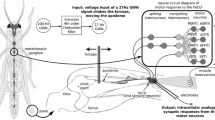Abstract
A mechanomyogram (MMG) from single motor units of the anconeus muscle in voluntary isometric contraction was recorded from seven subjects using a spike-triggered averaging technique. The MMG system, in which the input was an ideal impulse and the output was the MMG detected with an acceleration sensor, was identified as the fifth-order model by the subspace-based state-space model identification method. The transfer function of the MMG system was factorized to the second- and the first-order models. The second-order model was compared to the standard form of the second-order model, and its resonance frequency was calculated. The resonance frequencies of the second-order models were 166 ± 61 and 93 ± 27 Hz, which were within the range of the values estimated from mechanical impedance in the literature. The equivalent mechanical model of the MMG system of the single motor unit was proposed on the basis of the fifth-order model. The model might be useful to evaluate the visco-elastic properties of the anconeus muscle.







Similar content being viewed by others
References
Cescon C, Gazzoni M, Gobbo M, Orizio C, Farina D (2004) Non-invasive assessment of single motor unit mechanomyographic response and twitch force by spike-triggered averaging. Med Biol Eng Comput 42:496–501
Cescon C, Madeleine P, Graven-Nielsen T, Merletti R, Farina D (2007) Two-dimensional spatial distribution of surface mechanomyographical response to single motor unit activity. J Neurosci Methods 159:19–25
Cole GK, van den Bogert AJ, Herzog W, Gerritsen KGM (1996) Modeling of force production in skeletal muscle undergoing stretch. J Biomech 29:1091–1104
Farina D, Li X, Madeleine P (2008) Motor unit acceleration maps and interference mechanomyographic distribution. J Biomech 41:2843–2849
Kaczmarek P, Celichowsk J, Kasiński A (2005) Experimentally verified model of mechanomyograms recorded during single motor unit contractions. J Electromyogr Kinesiol 15:617–630
Khoo MCK (1999) Physiological control systems: analysis, simulation, and estimation. IEEE Press, Piscataway
Ljung L (1987) System identification: theory for the user. Prentice Hall, Upper Saddle River
Oka H, Yamamoto T (1987) Dependence of biomechanical impedance upon living body structure. Med Biol Eng Comput 25:631–637
Orizio C, Solomonow M, Diemont B, Gobbo M (2008) Muscle-joint unit transfer function derived from torque and surface mechanomyogram in humans using different stimulation protocols. J Neurosci Methods 173:59–66
Petitjean M (1995) Phonomyogram from single motor units during voluntary isometric contraction. Eur J Appl Physiol 71:215–222
van den Bogert AJ, Gerritsen KGM, Cole GK (1998) Human muscle modeling from a user’s perspective. J Electromyogr Kinesiol 8:119–124
Acknowledgments
This work was supported by Grant-in-Aid for Scientific Research.
Author information
Authors and Affiliations
Corresponding author
Rights and permissions
About this article
Cite this article
Uchiyama, T., Hashimoto, E. System identification of the mechanomyogram from single motor units during voluntary isometric contraction. Med Biol Eng Comput 49, 1035–1043 (2011). https://doi.org/10.1007/s11517-011-0752-0
Received:
Accepted:
Published:
Issue Date:
DOI: https://doi.org/10.1007/s11517-011-0752-0




